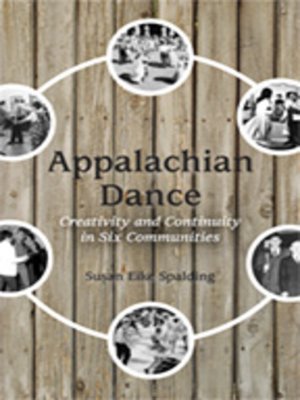
Sign up to save your library
With an OverDrive account, you can save your favorite libraries for at-a-glance information about availability. Find out more about OverDrive accounts.
Find this title in Libby, the library reading app by OverDrive.



Search for a digital library with this title
Title found at these libraries:
| Library Name | Distance |
|---|---|
| Loading... |
Spalding analyzes how issues as disparate as industrialization around coal, plantation culture, race relations, and the 1970s folk revival influenced freestyle clogging and other dance forms like square dancing in profound ways. She reveals how African Americans and Native Americans, as well as European immigrants drawn to the timber mills and coal fields, brought movement styles that added to local dance vocabularies. Placing each community in its sociopolitical and economic context, Spalding analyzes how the formal and stylistic nuances found in Appalachian dance reflect the beliefs, shared understandings, and experiences of the community at large, paying particular attention to both regional and racial diversity.
Written in clear and accessible prose, Appalachian Dance is a lively addition to the literature and a bold contribution to scholarship concerned with the meaning of movement and the ever-changing nature of tradition.
| Cover Title Contents List of Illustrations Preface 1. Dynamic Traditions 2. Lively Dance Currents 3. Old Time Dancing in Northeast Tennessee: Traditional Values in an Industrial Region 4. Blue Ridge Breakdown: Stability and Tradition in an African American Community 5. Mr. Perry's Sweet Shop and a New Old Time Dance 6. Dance at Pine Mountain Settlement School: Ideals and Institutions 7. "Rise and Shine": Dancing for Community Development at Hoedown Island 8. The Carcassonne Square Dance: A True Revival Afterword Notes Works Cited Index | Weatherford Award (Nonfiction), Berea College and the Appalachian Studies Association, 2014. — Berea College and the Appalachian Studies Association|Susan Eike Spalding has been dancing in the Appalachian region for almost three decades, and has served as a consultant for the Smithsonian Festival of American Folklife and the Kentucky Folklife Festival. She co-edited the book Communities in Motion: Dance, Tradition and Community, edited the dance entries for the Encyclopedia of Appalachia, and co-produced two Appalshop video documentaries on old-time dance. Her work has long focused on intercultural exchange and other societal factors that have helped to shape Appalachian dance.







